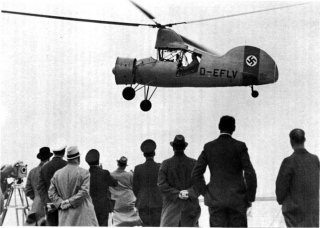How Nazi Germany’s Navy Developed the First Successful Helicopters
That honor of the first true helicopter goes to the Germans.
Even before the outbreak of the Second World War, aviation pioneers had been devising new types of aircraft and this included long-range heavy bombers and led to the night fighters, while both the Axis and Allies sought to develop the first jets. That led to the development of Nazi Germany's Me-163 Komet and Great Britain's Gloster Meteor.
Yet there was another aviation race in the works, one involving rotary aircraft.
While it is absolutely true that all modern military helicopters—from the UH-60 Black Hawk to the AH-64 Apache—can all be traced back to the Sikorsky R-4 and its prototypes, the design from Russian immigrant Igor Sikorsky wasn’t, in fact, the first helicopter, and it wasn't an air force or army air corps that saw the possibilities for such an aircraft but rather naval planners.
That honor of the first true helicopter goes to the German FlettnerFl 265.
Origins of Rotary Wing Aircraft—the Fl 265
German engineers were also working on various designs—but while Sikorsky's R-4 would go on to influence future rotary-wing aircraft design nearly all the German prototypes were dead ends on the aviation evolution tree. However, credit for this monumental “first” goes to the FlettnerFl 265, which was developed in the late 1930s, shortly before the outbreak of War World II.
Unlike the American Kellett KD-1 autogyro, which combined elements of fixed-wing aircraft—minus the wings—with a rotor blade to provide lift and a more traditional forward propeller system, the Fl 265 was a true rotary lift aircraft.
Interestingly, the Fl 265 wasn’t actually conceived for use with the German Luftwaffe (Air Force) but rather it was for the Kriegsmarine (Navy), which sought to create a vertical takeoff/landing craft that could be used on ships as the German military lacked a conventional aircraft carrier. The Kriegsmarine concluded that it would be necessary to develop three helicopters—one for use from a shore base, a compact shipboard model and a mini-version that could potentially be carried by submarines.
This resulted in the development of the experimental Fl 265. The aircraft was the brainchild of Anton Flettner, a German aviator and engineer who worked for Count Zeppelin during World War I. In total, six prototypes of Flettner's design were ordered for testing.
The thinking was these small, one-manned aircraft could be launched from surface ships or even specially-modified U-Boats and provide an “eye-in-the-sky” that was at the time nearly unavailable to the German Navy. The first flight of the Fl 265 was conducted in May of 1939, and although two were lost in subsequent flights, the craft proved so agile that none of the Luftwaffe’s fighter pilots could maneuver into firing position against the prototype helicopters.
While the tests seemed successful, Flettner and his team were working on an improved version.
The Fl 282Kolibri
The original plan to develop three variations was deemed to be impractical so instead, designers moved ahead with the improved Fl 282 Kolibri (Hummingbird), which ended the Fl 265 program.
Some twenty-four of the Fl 282 Kolibri helicopters were produced for both the Kriegsmarine and Luftwaffe during the war and these were constructed of welded steel tubes with removable sheet metal panels around the engine and fabric covering the tail section. The rotary aircraft featured tricycle landing gear, which made moving the aircraft on the ground easier but the Fl 282 was reportedly difficult to taxi on a runway.
While one pilot and aircraft were lost at sea during testing in May 1943, a few of the Kolibri flew operationally in the Baltic, Mediterranean and Aegean in a convoy protection role. Towards the end of the war the airplanes were stationed along the front with the invading Soviet forces and used as artillery spotters, but gradually were shot down by Soviet fighters and anti-aircraft fire.
None of the original Fl 265 prototypes survived the war, and only three of the Fl 282s survived, but only one is on display at the Midland Air Museum in Coventry, England, while the other two have been lost or sadly scrapped.
Peter Suciu is a Michigan-based writer who has contributed to more than four dozen magazines, newspapers and websites. He is the author of several books on military headgear including A Gallery of Military Headdress, which is available on Amazon.com.
Image: Reuters

